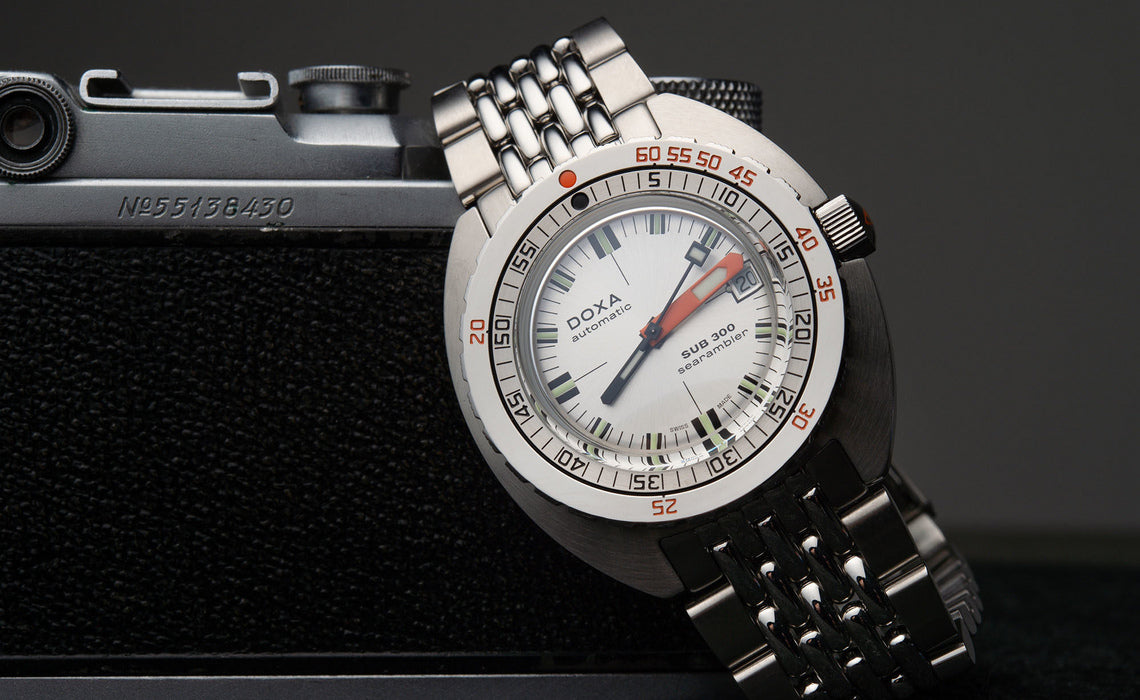Doxa SUB 300: Ancestor to Dive Computers

Nowadays, it is a common sight to see divers strap a digital dive computer to their wrist. At least, all dive instructors do and the most avid amateur divers do so as well. I don’t use a dive computer because I only dive occasionally and I prefer to wear a mechanical timepiece. Since I only dive with instructors, I don’t need the bells and whistles of dive computers. But, when I did train for my dive certifications, I realized how analog things were way back when. Divers used tables to calculate their bottom time as it related to the targeted depth and the quantity of air available in the tanks. They had to calculate all of that stuff prior to the dive. Now, they input their key data points and the computer does its magic.
It got me thinking: what tools did divers use before dive computers to calculate all of this and make sure they wouldn’t get into an accident? It got me further thinking about the Doxa SUB 300 and its unique bezel layout. So, let's talk about this watch which I see as being the ancestor to dive computers.
 Source: www.watchgecko.com
Source: www.watchgecko.com
The First Doxa SUB 300
Between the 1950s and the introduction of the first professional divers—the Rolex Submariner, the Blancpain Fifty Fathoms, and the Zodiac Sea-Wolf amongst others—dive watches often came with white or black dials and a count-up bezel. Monochromatic dials were easy to read as long as the dials were laid out clearly. But something new and bizarre was released in 1967: the first Doxa SUB 300. Although it came in different dial colors, the Doxa made a splash as the primary dial color was bright orange, something never seen before. Doxa conducted studies alongside professional dives and determined that orange was easier to see than black or white at greater depths. It has something to do with color hues.
 Source: www.watchcharts.com
Source: www.watchcharts.com
The first SUB 300 was therefore unique in the choice of dial color. It also came with a case that had an odd shape at the time, now known as “tonneau” (French for barrel) that had a characteristic flat and rounded profile. The SUB 300, as its names might have given it away, had a depth rating of 300 meters which was much greater than most divers at the time. Furthermore, it came with an unusual handset where the hour hand is much smaller than the minute hand, which makes sense given its intended use. And perhaps the most daring novelty was the dual-scale bezel insert which had never been seen before. All of these features put together explain why Jacques Cousteau became a fan of the SUB300 and helped in making it an instant icon.
 Source: www.timeandtidewatches.com
Source: www.timeandtidewatches.com
The Unique Bezel Design of the SUB 300
During my scuba diving training, I was handed paper tables that showed how much time one could dive according to how deep one goes. I never really got the hang of it and didn’t feel the need to since it was always my instructor’s responsibility to know this information. But I got the basic idea. And it seemed, for the most part, that divers had to figure out how long they could stay underwater to avoid doing the decompression stops before submerging themselves into the ocean. I saw examples of divers that had a printed scale on the rubber strap showing different depths and corresponding bottom times. (Bottom time means how long one can stay at the maximum depth.)
 Source: www.ethoswatches.com
Source: www.ethoswatches.com
Doxa figured out a more intuitive way to go about this. Used in conjunction with no-decompression limit tables—which show how long one can stay at certain depths before having to make decompression stops—the dual-scale bezel of the SUB 300 indicates, almost immediately, how long one can stay at a specific depth. (I know, it sounds a bit redundant.) Divers only had to align the zero mark to the minute hands and read how long they can stay underwater at certain depths. For example, the bezel can be used to see that one can stay up to 50 minutes at a depth of 18 meters before having to make decompression stops.
This was ingenious and made calculations much easier for everyone, for both the instructors and amateur divers. I just hope my explanation makes sense!
 Source: www.watchonista.com
Source: www.watchonista.com
Final Thoughts
Although we no longer need this type of bezel and watch to dive, I find it pretty ingenious that Doxa came up with this design. It made preparing for the dives easier and more precise. And the dual-scale bezel which made Doxa popular starting in the 1960s is what continues to attract collectors to this model. That and the bright orange dial color.
Featured image: www.passion-horlogere.com








Leave a comment